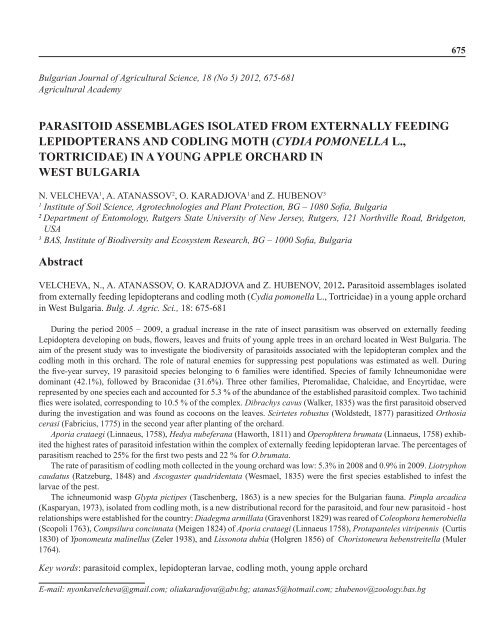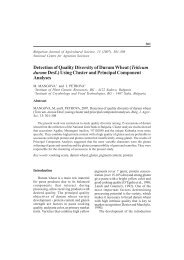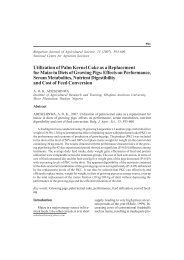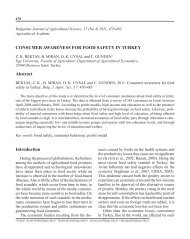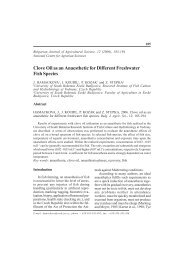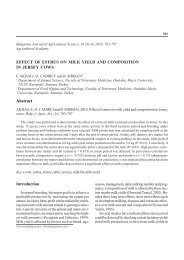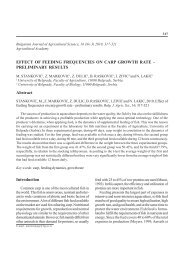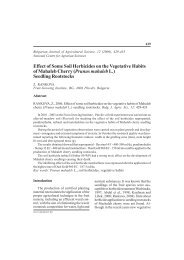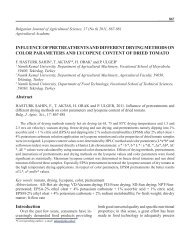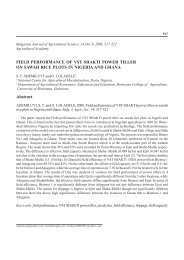parasitoid assemblages isolated from externally feeding ...
parasitoid assemblages isolated from externally feeding ...
parasitoid assemblages isolated from externally feeding ...
You also want an ePaper? Increase the reach of your titles
YUMPU automatically turns print PDFs into web optimized ePapers that Google loves.
Parasitoid Assemblages Isolated From Externally Feeding Lepidopterans and Codling Moth... 677Table 1Taxonomic list of the hosts and reared <strong>parasitoid</strong>sLepidopteran larvae and pupaeParasitoidsFamily, subfamily,tribeSpeciesFamily, subfamily,tribeSpeciesTortricidae Cydia Ychneumonidae Liotryphon caudatus (Ratzeburg, 1848)Olethreutinae pomonella Pimplinae,EphialtiniGrapholitini ( Linnaeus, 1758) Pimplinae, Pimplini ***Pimpla arcadica (Kasparyan, 1973)BraconidaeCheloninaeAscogaster quadridentata(Wesmael,1835)Pteromalidae Dibrachys cavus (Walker, 1835)PteromalinaeTachinidae Elodia morio (Fallen, 1820)ExoristinaeTortricidae Hedya Braconidae Apanteles candidatus (Haliday, 1834)Olethreutinae nubeferana MicrogasterinaeOlethreutini (Haworth, 1811) Chalcidae Brachymeria tibialis (Walker, 1834)ChalcidinaeTortricidae Archips Ychneumonidae Itoplectis maculator (Fabricius, 1775)Tortricinae xylosteana Pimplinae, PimpliniArchipini (Linnaeus, 1758)Tortricidae Archips Braconidae Macrocentrus linearis (Nees, 1811)Tortricinae crataegana MacrocentinaeArchipini (Hubner, 1799)Tortricidae Choristoneura YchneumonidaeTortricinae hebenstreitella Banchinae **Lissonota dubia (Holgren, 1856)Archipini (Muller, 1764) AtrophiniGeometridae Operophtera BraconidaeLarentiinae brumata Microgasterinae Protapanteles immunis (Haliday, 1834)Operophterini (Linnaeus, 1758)Noctuidae Orthosia YchneumonidaeNoctuinae cerasi Campopleginae Scirtetes robustus (Woldstedt 1877)Orthosiini (Fabricius, 1775)Noctuidae Cosmia YchneumonidaeNoctuinae trapezina Campopleginae Scirtetes robustus (Woldstedt, 1877)Xylenini (Linnaeus, 1758)Pieridae Aporia BraconidaePierinae crataegi Microgastrinae Cotesia glomerata (Linnaeus, 1758)Pierini (Linnaeus, Tachinidae1758****) Exoristinae **Compsilura concinnata (Meigen, 1824)YponomeutaYchneumonidaemalinellus Campopleginae Diadegma armillata (Gravenhorst, 1829)(Zeller, 1938)Yponomeutidae **** Braconidae **Protapanteles vitripennis (Curtis, 1830)Yponomeutinae Microgasterinae = Apanteles vitripennis (Curtis, 1830)= Glyptapanteles vitripennis (Curtis, 1830)ChalcidoideaEncyrtidae Ageniaspis fuscicollis (Dalman, 1820)EncyrtinaeSwamerdamia pyrella Ychneumonidae Gelis sp. secondary <strong>parasitoid</strong>pyrellaCriptinae(Villers 1789)PhygadeuontiniGelechiidae Not identified Ychneumonidaeto species Banchinae *Glypta pictipes (Taschenberg, 1863)GlyptiniColeophoridae Coleophora Ychneumonidae **Diadegma armillata (Gravenhorst, 1829)hemerobiellaCampopleginae(Scopoli, 1763)*New species for Bulgarian fauna; **New host <strong>parasitoid</strong> relation; ***New distributional record for Bulgaria;****The number of the larvae of these pests was not included in the sum of found because of gregarious manner of <strong>feeding</strong> in nests.
Parasitoid Assemblages Isolated From Externally Feeding Lepidopterans and Codling Moth... 679and Bactromyia aurulenta (Meigen, 1824) as <strong>parasitoid</strong>sof Y. mallinellus in Bulgaria. Hence, the list ofinsects known to parasitize Y. mallinellus in Bulgariaincludes 27 species.The oligophagous ichneuomonid wasp Scirtetesrobustus (Woldstedt), which develops in noctuid larvae,was one of the first <strong>parasitoid</strong>s to appear in theyoung apple orchard. One infested larva of Orthosiacerasi (Fabricius, 1775) was found on 3.05.2007, andS. robustus emerged on 17.03.2008.The species which first parasitized the codlingmoth were Liotryphon caudatus (Ratzeburg 1848) andAscogaster quadridentata (Wesmael, 1835). The firstfound <strong>parasitoid</strong> in young orchard D. cavus emerged ofcodling moth larvae on 27.07.2009.In total, five <strong>parasitoid</strong>s were <strong>isolated</strong> <strong>from</strong> codlingmoth larvae, collected in the young apple orchard.Two of them belong to family Ychneumonidae, oneto Braconidae, and one to Pteromalidae (Table 1). A.quadridentata was the only egg-larval <strong>parasitoid</strong>. Thelist of <strong>parasitoid</strong> species <strong>isolated</strong> <strong>from</strong> codling mothdeveloping in the fruits of aged untreated apple treesin the vicinity of the investigated experimental orchardcomprised two more representatives of familyYchneumonidae – the solitary larval endo<strong>parasitoid</strong>Pristomerus vulnerator (Panzer, 1799) (Cremastinae)and the solitary pupal endo<strong>parasitoid</strong> Pimpla turionellae(Linnaeus, 1758) (Pimplinae), as well as one morespecies <strong>from</strong> family Braconidae – Bassus (Microdus)rufipes (Nees, 1812). The list did not include Pimplaarcadica (Kasparyan, 1973) which was <strong>isolated</strong> <strong>from</strong>codling moth in the young orchard. According to Kolarov(1997), P. arcadica is very rare and was foundby the author in April only in Strandzha mountain inour country. The species was first described <strong>from</strong> TheCrimea by Kaparjan (1973). Consequently, it was reportedfor Sweden (Yu et al., 2005), Norway (Hansenet al., 2010) and the North-East Anatolian Region ofTurkey (Coruh, 2010). Obviously, P. arcadica Kas.develops two generations per year - in Turkey it wascollected in June and August (Coruh, 2010), while ourspecimen emerged on 12.08.2009.The <strong>parasitoid</strong> tachinid fly Elodia morio (Fallen,1820) emerged <strong>from</strong> codling moth larvae collectedwith bands <strong>from</strong> both the young and the aged appletrees. The <strong>parasitoid</strong> was registered for the first timein 2008, four years after planting of the orchard. Tenwasps of the family Ichneumonidae were listed as larvaland pupal <strong>parasitoid</strong>s of C. pomonella in Bulgariaby Atanassov (1986) and eleven braconids were listedby Balevski (2009). Aleiodes bicolor (Spinola, 1808)and Microgaster meridiana (Haliday, 1834) were reportedas <strong>parasitoid</strong>s of codling moth by Peeva et al.(2010) and P. arcadica (Kasparyan, 1973) by Kolarov(1997). We also <strong>isolated</strong> Exorista fasciata (Fallen,1820) <strong>from</strong> codling moth larvae collected in an organicorchard in Plovdiv region. This is a new report of host- <strong>parasitoid</strong> relationship, contributing to the extensivehost list compiled by Hubenov (1985, 2001). With theaddition of Elodia morio (Fallen, 1820) first announcedby Trenchev (1980), the Bulgarian faunistic list of<strong>parasitoid</strong>s of the codling moth now comprises 26 parasoitoids.So, 19.2% of all <strong>parasitoid</strong> species known tooccur in our country were attracted immediately afterthe appearance of their host in the young apple orchard.According to Lloyd (by Laurence et al., 2005), thereare over 100 insect species parasitizing the codlingmoth worldwide.The rates of parasitism on codling moth establishedin our study and presented in Table 2 were very low.There are similar reports of considerably low rates ofparasitism on C. pomonella. For example, Monteiro etal. (2010) reported mean rates of infestation of 3.7%,2.3% and 0.8% in organic and conventional with andwithout mating disraption in France. The authors didnot find parasitized diapausing codling moth larvae in79% and 83.6% of the observed apple orchards.In the period 1994 – 1995, the reported mean rateof infestation of the codling moth in Switzerland (LaTable 2Relative density of codling moth, <strong>externally</strong> leavinglepidopteran larvae and mean rate of parasitismYearsMean numberof diapausingcodling mothlarvae/bandRate ofparasitsm,%Relativedensity oflarvae on100 organsRate ofparasitism,%2005 0 0 6.7 02006 0 0 8.8 32007 3.1 0 16.7 52008 11.9 5.3 13.9 8.92009 7.8 0.9 8.6 9
680 N. Velcheva, A. Atanassov, O. Karadjova and Z. HubenovCôte) was 3% and in Göttingen, South Germany –4.9% (Atanassov et al., 1997). Subinprasert (1987)established a rather different rate of parasitism in SouthSweden, ranging <strong>from</strong> 22.9% to 61.1% during the period1981-1984, or mean - 38.3%. Perhaps, the reasonwas that his investigations were performed in very oldapple orchards, planted about 50 years ago. Tkachev(1986) also reported a high percentage of parasitism,reaching up to 27%, <strong>from</strong> Ukraine.ConclusionsNineteen <strong>parasitoid</strong> species belonging to six familieswere reared <strong>from</strong> the lepidopteran pests collected<strong>from</strong> the young apple orchard. Species of familiesIchneumonidae were dominant (42.1%), following byBraconidae (31.6%). Parasitoid flies <strong>from</strong> family Tachinidaehad a relative abundance of 10.5%, and threefamilies - Pteromalidae, Chalcidae, and Encyrtidaewere represented by one species each, accounting for5.3 % of established <strong>parasitoid</strong> complex. It can be supposed,that the first reared <strong>parasitoid</strong> species generallyhave a very high searching ability and detect their hostsearlier than others, or that they have found better livingconditions in the crowns of the young trees, comparedwith other environments.Dibrachys cavus (Walker, 1835) was the first <strong>parasitoid</strong>to appear in the young apple orchard. It was foundas cocoons on the leaves in the crowns of the appletrees.Scirtetes robustus (Woldstedt, 1877) parasitized larvaeof Orthosia cerasi (Fabricius, 1775) in the secondyear after planting of the orchard, in 2006. The ichneumonidwasp emerged in 2007.Two <strong>parasitoid</strong>s were <strong>isolated</strong> <strong>from</strong> one of the dominantpests - Hedya nubiferana (Haworth, 1811). Therate of infestation of its larvae was high in the fourthand the fifth year after planting of the orchard. The establishedrates of parasitism were related to the densityof the pest.The rates of parasitism of the other of dominant speciesin the complex of <strong>externally</strong> <strong>feeding</strong> Lepidoptera,Operophtera brumata (Linnaeus, 1758), graduallyincreased during the years of investigation and reached22% in 2009.The phytophagous insect Aporia crataegi Linnaeus(1758) exhibited a high rate of <strong>parasitoid</strong> infestationreaching 25%.Liotryphon caudatus (Ratzeburg, 1848) and Ascogasterquadridentata (Wesmael, 1835) were the first<strong>parasitoid</strong> species reared <strong>from</strong> codling moth. Five <strong>parasitoid</strong>swere <strong>isolated</strong> altogether. The rate of infestationof codling moth was too low to play a significant rolein decreasing the populations of the pest.The ichneumonid wasp Glypta pictipes (Taschenberg,1863) is a new species for the Bulgarian fauna.Pimpla arcadica (Kasparyan, 1973) reared <strong>from</strong>codling moth is a new distributional record for the<strong>parasitoid</strong>.Four new <strong>parasitoid</strong> - host relationships wereestablished for the country: Diadegma armillata(Gravenhorst, 1829) - Coleophora hemerobiella (Scopoli,1763), Compsilura concinnata (Meigen, 1824)- Aporia crataegi (Linnaeus, 1758), Protapantelesvitripennis (Curtis, 1830) - Yponomeuta malinellus(Zeler, 1938), and Lissonota dubia (Holgren, 1856) -Choristoneura hebenstreitella (Muler, 1764).AcknowledgementsThe present study is partly supported by project DO-02-57/2008 funded by Fund “Scientific Investigation”,Ministry of Education, Youth and Science, Bulgaria.ReferencesAngelova, R., 1983. Parasites of leaf rollers (Subfamily Tortricinae,Lep.) in apple orchards.”Vasil Kolarov” HigherInstitute of Agriculture –Plovdiv, Scientific works,XVIII: 95-102.Atanassov, A. Z., 1986. An annotated list of the parasites(Ichneumonidae, Hymenoptera) on the pests in Bulgaria.Bull. IOBC, East Paleartic Section, 14: 7-19.Atanassov, A., P. J. Charmillot, Ph. and D. Jeanneret,1997. The larval and pupal <strong>parasitoid</strong>s of codling mothCydia pomonella. Revue suisse de viticulture, arboriculture,horticulture, 29 (2) : 100-106.Balazs, K., 1997. The importance of the <strong>parasitoid</strong>s in appleorchards. Biological. Agric. Hortic., 15: 123-129.Balevski, N., 2009. Biodiversity, host specialization and trophicrelations of braconid <strong>parasitoid</strong>s (Hymenoptera: Braconidae)phytophagous insect pests - plants hosts. Habilitationthesis, Plant Protection Institute, Bulgaria, 211 pp.
Parasitoid Assemblages Isolated From Externally Feeding Lepidopterans and Codling Moth... 681Cerretti, P. and H. P. Tschorsnig, 2010. Annotated host cataloguefor the Tachinidae (Diptera) of Italy. StuttgarterBeiträge zur Naturkunde A, Neue Serie, 3: 305–340.CMISS, 2009. Codling moth informationsupport system.Natural enimes of codling moth and leafrollers of pomeand stone fruits [http://www.ipmnet.org/Codling moth/biocontrol/naturale/].Coruh, S., 2010. Composition, habitat, distribution and seasonalactivity of Pimplinae(Hymenoptera: Ichneumonidae) in North-East Anatolia regionof Turkey. Anadolu J. Agric. Sci., 25(1): 28-36.Evenhuis, H. H. and H. J. Vlug, 1983. The hymenopterousparasites of leaf-feading apple tortricids (Lepidoptera,Tortricidae) in the Netherlands. Tijdschrift Voor Entomologie,126: 109-135.Fauna Europaea. 2010,[http:www.faunaeur.org], version 2.4.Hansen, L. O., A. Humalaand and A. Reshchikov, 2010.Ichneumonidae (Hymenoptera) new for the fauna ofNorway, Part 4. Norwegian Journal of Entomology, 57:177–186.Hubenov, Z., 1985. On hosts of family Tachinidae (Diptera)species in Bulgaria. Acta Zool. Bulg., 27: 27-35.Hubenov, Z., 2001. Addition to the list of hosts of the BulgarianTachinidae (Diptera). Acta Entom. Bulg., 7 (No3,4): 51-56.Ichiki, R. and S. Nakamura, 2007. Oviposition and immaturedevelopment of the <strong>parasitoid</strong> fly Compsiluraconcinnata (Meigen) (Diptera: Tachinidae). JARQ 41(3): 227 – 232. http://www.jircas.affrc.go.jp.Ivanov, Sp. and N. Slavov, 1982. The more significant leafrollersparasites in Plovdiv region. The Third NationalScience Conference of Pest Biological Control. 25-30.10.1982, Sofia, 15-16.Jacentkosky, D., 1936. Beitrag zur Kenntnis der Raupenfliegen(Tavhinidae, Diptera)Bulgariens. Mitteilungen aus den Kőnigl. NaturwissenschaftlichenInstituten in Sofia. Mitteilungen aus denKőnigl. Naturwissenschaftlichen Instituten in Sofia-Bulgarien.Kasparyan, D. R., 1973. [New species of the genus PimplaF. (Hymenoptera, Ichneumonidae) <strong>from</strong> the Crimea, theCaucasus and Soviet central Asia.] (In Russian with Armeniansummary). Doklady Akademii Nauk ArmyanskoiSSR, 57 (4): 252-256.Kolarov, J., 1997. Fauna Bulgarica.25 Hymenoptera, Ichneumonidae.Part I. Pimplinae, Xoridinae, Acaenitinae,Collyriinae. Editio Academica “Prof. Marin Drinov”,Editio“PenSoft”, 326 pp.Lacey, L. A. and T. R. Unruh, 2005. Biological control ofcodling moth (Cydia pomonella, Lepidoptera: Tortricidae)and its role in integrated pest management, withReceived November, 12, 2011; accepted for printing June, 2, 2012.emphasis on Entomopathogens. Monograph. Vedalia, 12(1): 33-60.Lecheva, I. and A. Zaprjanov, 1996. Geometrids (Lepidoptera:Geometridae) and their <strong>parasitoid</strong>s (Hymenoptera:Ichneumonoidea) in fruit orchards in Bulgaria.Acta Entom. Bulg., 1: 68- 71.Monteiro, L. B., C. Dor, P. Franck, C. Lavigne and B.Sauphanor, 2010. Pest management ptactices and environmentfactors affect natural regulation of codling moth.IOBC/wpr Bulletin, 54: 248-251.Nikolova, V., 1962. The more important injurious Tortricidaeand Gelechiidae on fruit trees in Bulgaria and theirparasites. Bull. Central Res. Institute of Plant Protection,(3): 91-116 (Bg).Peeva, P., 2009. Species diversity of lepidopteran pests inapple orchards. PhD thesis, Plant Protection Institute, Sofia,181 pp. (Bg).Peeva, P., N. Velcheva and N. Balevski, 2010. New <strong>parasitoid</strong>sof Braconidae (Hymenoptera) infected lepidopterouslarvae in apple biocenoses in Bulgaria. Plant Sci., 46(4): 346-350 (Bg).Pluciennik, Z. and R. W. Olszak, 2010. The role of <strong>parasitoid</strong>sin limiting the harmfulness of leaf rollers in appleorchards. J. of Plant Protection Research., 50 (1): 1-8.Popov, P. A., 1956. Contribution to the biology, ecologyand prognosis of Hyponomeuta malinellus Z. Scientificworks, Ministry of Agriculture, series Plant growing, І,4: 21-36 (Bg).Subenprasert, S., 1987. Natural enemies and their impacton over wintering codling moth populations (Laspeyresiapomonella L.) (Lep., Tortricidae) in South Sweden. J.Appl. Ent., 3: 46-55.Tschorbadjieff, P., 1933. Les Insectes Nuisibles sur Les ArbresFruitiers en Bulgarie.Tkachev, V. M., 1986. Protection of apple. Zashita rastenii,(No 5): 24-25 (Ru).Trenchev, G., 1980. Parasite species of the subfamily Exoristinae(Diptera, Tachinidae) in Bulgaria. Plant Sci.,XVII (No 5): 121-125 (Bg).Velcheva N., 2009. Lepidopterian fauna in new-plantedapple orchard in West Bulgaria. Biotechnology and BiotechnologicalEquipment - special issue, 23: 127-131.www.diagnosisp.comYu, D. S., K. van Achterberg and K. Horstmann, 2005.World Ichneumonidea 2004. Taxonomy, Biology, Morphologyand Distribution. CD/DVD. Taxapad, Vancouver,Canada.Zerova, M. D., Zh. Melika, V. I. Tolkanik and A. G. Kotenko,1989. Annotated list of insects parasitizing leaf rollers,which damaged apples in the South West of the Europeanpart of USSR. Information Bulletin EPS, 28: 7-69.


